
The 1st i get this injuries was August 2006. And last week, it happens again. But it is not the 2nd, it is the 4th!!! Uhuhu..ok what is ACL that i'm talking about??
Ok, here's the information...i copy this thing from webmd.com :
What is the anterior cruciate ligament (ACL)?
The anterior cruciate ligament (ACL) is one of four knee ligaments that connect the upper leg bone (femur) with the lower leg bone (tibia). The ACL stabilizes knee movement by:
- Preventing the lower leg bone from sliding forward or turning when the leg is straight.
- Preventing the knee from being stretched or straightened beyond its normal limits (hyperextended).
- Supporting the knee ligaments that keep the knee from bending sideways.
See an illustration of the knee and the ACL
What is an ACL injury?
An ACL injury can involve a small or medium tear of the ligament, a complete tear of the ligament (rupture), a separation of the ligament from the upper or lower leg bone (avulsion), or a separation of the ligament and part of the bone from the rest of the bone (avulsion fracture). When any of these occur, the lower leg bone may move abnormally forward on the upper bone, with a sense of the knee being unstable.
Without treatment, an ACL injury may develop into long-lasting chronic ACL deficiency and knee instability. The ability of the ACL to control knee movement decreases, and the abnormal bone movement also can damage the tissue that covers the ends of bones (cartilage
) and trap the pads that cushion the knee joints (menisci). This damage can lead to premature osteoarthritis.
When you injure your ACL, other parts of the knee can be injured at the same time, including the meniscus
, other knee ligaments, cartilage, or bones in the knee joint, which may be broken.
What causes an ACL injury?
Your ACL can be injured if your knee is hyperextended, twisted, or bent side to side. The risk of injury is higher if a combination of these movements occurs at one time. Contact (being hit by another person or object) also can cause an ACL injury.
An ACL injury often occurs in sports when the foot is firmly planted on the ground and a sudden force is applied to the knee while the leg is straight or slightly bent. Examples of this include changing direction rapidly, slowing down when running, and landing from a jump. This type of injury is common in athletes who play sports that require stop-and-go movements, jumping, or weaving through other players or obstacles. These sports include football, soccer, basketball, and skiing.
ACL injuries outside of sports may be caused by accidents, such as falling off a ladder or missing a step on a staircase. The ACL, like any other body structure, becomes weaker with age, so a tear occurs more easily in those 40 years of age or older who are active or still involved in sports. When contact causes an ACL injury, it may be from playing a sport (such as being tackled in football), from a sudden and severe accident, or from less obvious injuries that were caused by contact.
What are the symptoms?
The symptoms of an ACL injury depend on whether the injury is acute (sudden) or you have chronic ACL deficiency.
An acute ACL injury happens suddenly, often when playing sports. After an acute injury, you will almost always have to stop the activity you are engaged in, but you may be able to walk. Symptoms of an acute ACL injury include:
- Feeling or hearing a pop in the knee at the time of injury.
- Sudden instability in the knee (the knee feels wobbly, buckles, or gives out) after a jump or change in direction or after a direct blow to the side of the knee.
- Pain on the outside and back of the knee.
- Knee swelling within the first few hours of the injury. This may be a sign of bleeding inside the knee joint (hemarthrosis). Swelling that occurs suddenly is usually a sign of a serious knee injury.
- Limited knee movement because of pain and/or swelling.
The main symptom of chronic ACL deficiency is the knee buckling or giving out, sometimes with pain and swelling. This may happen more and more often if the ACL is not treated.
I think..i have copied the main part of it. If your interested to find out more, just click this link.
And this is my picture last May. I got my 3rd injuries and i went to the Tai Chi Association to meet this angkol (uncle).
- Check my injuries first. Ask me, "Apa yang sakit?". "Lutut saya angkol. Bengkak and susah mau jalan. Boleh bengkok sampai 90 degree saja", i answered him. Then he began to 'scan' the injuries with just touching+pressing hard..very strong la this angkol. Like he is pressing the acupunture spot.
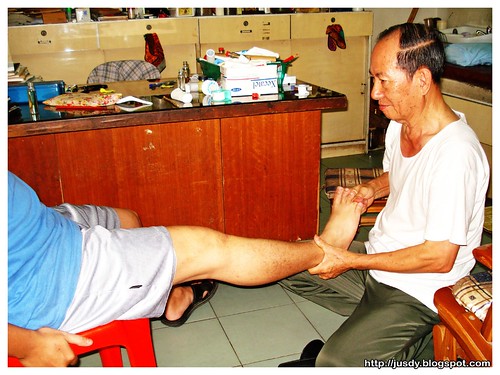
- Then he began his treatment. Just look at his fingers pressing my knee.Uhh!! Before i forgot, my right knee is the problem, but he touched my elbow, left foot, my jari kaki..then after 3-4 minutes, he said,"Cuba you jalan skrg..". I walked and my knee feels 'longgar' compared before the treatment.
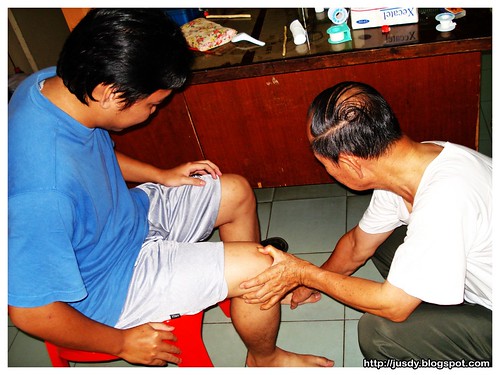
- After that he gave me pills and put his medicine with the bandage. But surely, this is not the best treatment for ACL. Better just go to the clinic meet the doctor.
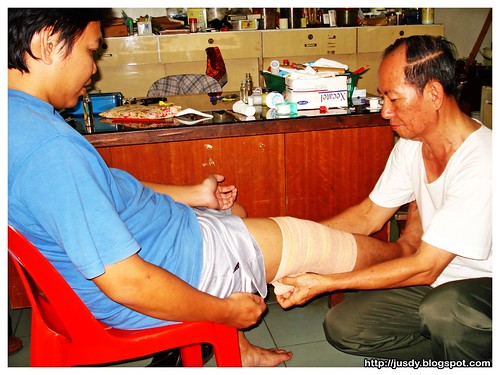
- This is outside angkol's room..
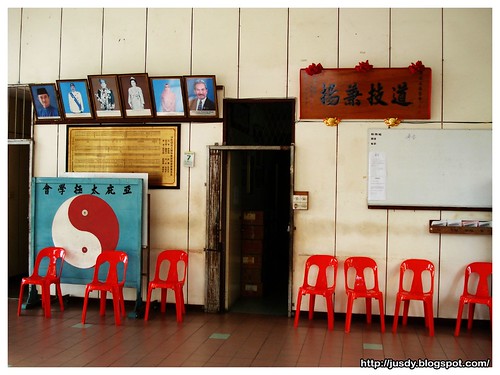
- And this is outside the building situated at Likas.

- And this is my knee while im stuck in traffic jam at Likas Bay.
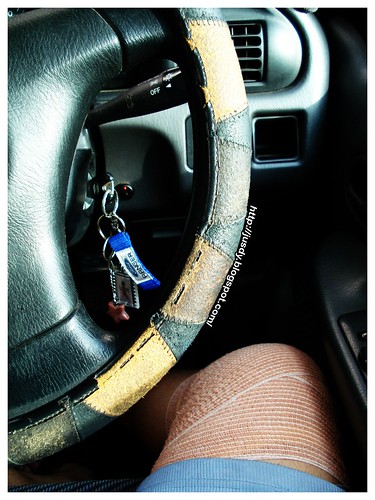
Hurm....i think i've to tell Alex Ferguson that i can't accept their contract. My football career is finished. Very sad......
1 comment:
hehe...sa pun tidak tau o mcm mana ej a sinsang...ekekeke milimewa mana ni a??
Post a Comment